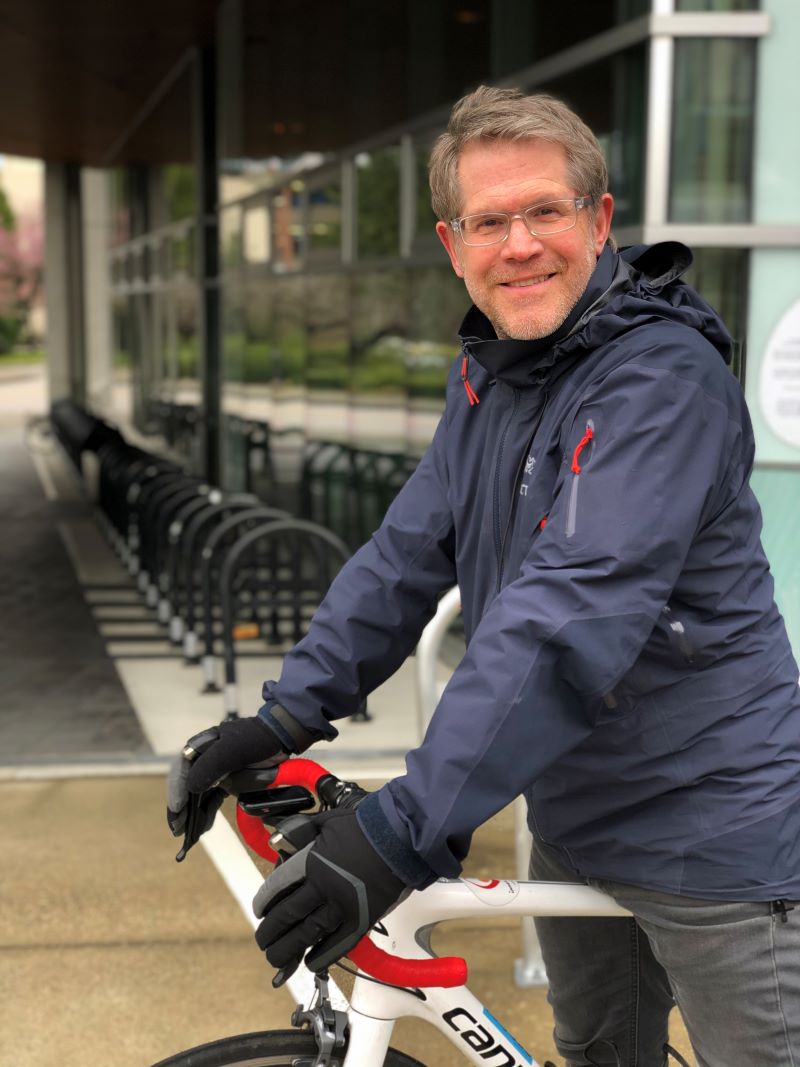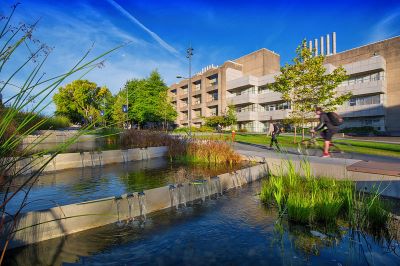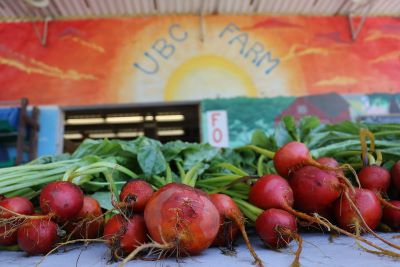UBC is getting ready to kick off a three-week university-wide engagement process on a new Climate Action Plan for both the UBC Vancouver and UBC Okanagan campuses (CAP 2030). To explain what it’s all about, John Madden, Director of Sustainability and Engineering in UBC Campus and Community Planning, breaks down why we need CAP 2030, what it means for you, and why it needs your voice.

First off, what is a Climate Action Plan?
A climate action plan lays out a path to reduce carbon emissions, with targets and actions to achieve those targets. UBC’s Climate Action Plan 2030—with separate plans for both the UBC Vancouver and UBC Okanagan campuses—will map out where we need to focus our efforts and resources to enable our campus communities, infrastructure, and buildings to be able to proactively address and respond to climate change. It will also serve as the first climate action plan for the UBCO campus.
UBC's previous Climate Action Plans set targets for emission reductions. These plans are helping to guide actions that are advancing UBC to reduce its emissions by nearly two thirds below 2007 emission levels within the next year or so.
Now, our sights are set on accelerating and expanding our scope of actions over the next 10 years... how we can advance toward net zero emissions...as well as address emissions associated with food, commuting, waste and air travel.
With CAP 2030, we are charting a more aggressive path, and expanding our targets and actions to establish an accelerated pathway to becoming net zero before 2050.
Why does UBC need a new Climate Action Plan?
One big impetus is to respond to the December 2019 UBC Declaration on the Climate Emergency, which was championed by student mobilization and endorsed unanimously by the Board of Governors. The declaration set out a number of commitments, including accelerating our ambitions around climate change mitigation.
 It’s also time to update our plan. When we developed our first climate action plan in 2010, we didn't really know the technological pathways and all the measures and actions that would get us to our long range targets of net zero by 2050. And a lot has changed since our last Climate Action Plan update in 2016. There are a host of new and innovative low-carbon technologies, opportunities for UBC’s buildings to reduce carbon both in operations and in the materials used (or not used). And there has been a scheduled increase on the price of emitting carbon to reflect the impacts and account for the significant cost of inaction which creates a financial incentive for UBC’s buildings to reduce its carbon and energy footprint.
It’s also time to update our plan. When we developed our first climate action plan in 2010, we didn't really know the technological pathways and all the measures and actions that would get us to our long range targets of net zero by 2050. And a lot has changed since our last Climate Action Plan update in 2016. There are a host of new and innovative low-carbon technologies, opportunities for UBC’s buildings to reduce carbon both in operations and in the materials used (or not used). And there has been a scheduled increase on the price of emitting carbon to reflect the impacts and account for the significant cost of inaction which creates a financial incentive for UBC’s buildings to reduce its carbon and energy footprint.
And another big motivator is the 2018 report from the Intergovernmental Panel on Climate Change that warned we had 12 years left to act before catastrophic impacts around climate change would affect our lifestyle and our planetary health. Two years on, we essentially have just a decade to act!
With CAP 2030, we are charting a more aggressive path, and expanding our targets and actions to establish an accelerated pathway to becoming net zero before 2050.
How will the focus of CAP 2030 be different from previous climate action plans?
The breadth and scope of this updated climate action plan is much greater than previous plans. Our previous climate action plans have focused on reducing direct emissions from the energy that we consume to heat our buildings and operate our campus. These plans included a series of measures to create the UBC Green Building Action Plan that identifies performance targets for new buildings to achieve deep energy and carbon reductions, and expand our bioenergy facility to provide low-carbon thermal energy to campus buildings. It also included a series of measures to improve and retrofit our existing buildings to be much more energy efficient, and transition away from fossil fuel use.
As a university community, we have a unique ability to support a culture shift—one that enables individuals to play a role, to actively participate in shifting behaviors and choices, and to advocate for innovation and leadership on climate action.
Our ambitions now are to start enabling our influence and our institutional and intellectual capabilities to go beyond just our operational emissions. As a university community, we have a unique ability to support a culture shift—one that enables individuals to play a role, to actively participate in shifting behaviors and choices, and to advocate for innovation and leadership on climate action. We see an opportunity to indirectly influence what we call extended impact areas, which come down to the choices we make around things like food, waste, transportation and air travel. We see these as major areas in which we can have an impact as individuals and as an institution.
 Can you expand on the role that food plays in UBC’s carbon footprint?
Can you expand on the role that food plays in UBC’s carbon footprint?
Food is a major area in which UBC can build understanding of the role that we, as individuals, can make. The food that we consume generates emissions through its production, packaging, transportation, storage and preparation. And, of course, there are opportunities to lower these emissions by reducing our food waste; the Food and Agriculture Organization (FAO) of the United Nations has estimated that if food waste was a country, it would be the third-highest emitter of greenhouse gases after the U.S. and China.
We see opportunities to encourage a shift to a more plant-based, or hybrid diet. To do that, we’re exploring a climate-friendly food labelling project to help people understand the estimated impacts of their choices associated with meat-based diets versus plant-based diets, and use that as a basis to understand how we can better manage our food choices and selection.
Food and Agriculture Organization (FAO) of the United Nations has estimated that if food waste was a country, it would be the third-highest emitter of greenhouse gases after the U.S. and China.
We also see opportunities to help reduce food waste and associated transportation emissions by buying fresh, locally produced, organic and healthy food. This supports multiple objectives around our ambitions of health and wellbeing, and around supporting more local business and local farmers, including the UBC Farm. Already, our UBC Food Services, Student Housing and community services are doing fantastic work around developing climate-friendly food menus, like introducing a new burger patty that combines plant proteins with meat to increase the proportion of plant-based proteins. In our commercial enterprises on campus, we can have an indirect influence by working with people to use their purchasing power to influence the choices that are being offered.
How does transportation play into UBC’s emissions reduction plans?
UBC has a big opportunity to support a mode shift from the private automobile to more sustainable modes of transportation, such as transit, biking and walking. Part of this is being addressed by providing more on-campus student, faculty and staff housing, which reduces the amount of vehicle kilometers travelled to and from campus.
But there are other opportunities. As we learned during COVID-19, the university pivoted quite successfully to remote working and learning. Rather than bounce back to business as usual, how can we bounce forward to facilitate and encourage remote work going forward? How can we learn from the past year to inform how future work arrangements can support reduced commuting emissions, good health and wellbeing, improved productivity and happiness? It demonstrates great leadership on behalf of the university to support a structural change in the way we think about work and learning.
Obviously, this depends on the needs of individual units and their operational considerations, but managers can help support folks to work from home where possible, and lessen the GHG emissions associated with their commutes to and from campus. This also frees up capacity on our transportation system for more essential goods and services movement.
Another aspect is business air travel, which offers a major opportunity to reduce emissions. We want to think about developing a flexible model where we encourage, facilitate and enable people to make alternative choices around flying—whether it’s to a conference, for professional development, or for research. This is not to say that members of the UBC community can’t do these things. It’s about understanding the impacts of decisions to travel, and providing alternative opportunities and platforms that could allow people to conduct their research, work or professional development through enhanced remote connections. The university can play an expanded leadership role in facilitating and supporting virtual and digital conferencing.
We have an obligation as a university to take a leadership role in this. It’s not about a top-down approach, but a collective approach that enables individuals working together to have a positive collective impact.
What measures is UBC considering to encourage and support choices around food, waste, and transportation?
Part of what this emerging Climate Action Plan 2030 intends to do is build a series of toolkits and campaigns to help people understand the potential positive impact they can make as individuals, explore ways of rewarding and recognizing these positive choices, and connect people to the technologies and alternatives that support this transition. We’re exploring different mechanisms, tools, programs and campaigns that will help incentivize people to make those choices. We have an obligation as a university to take a leadership role in this. It’s not about a top-down approach, but a collective approach that enables individuals working together to have a positive collective impact.
How will CAP 2030 play out across both the UBC Vancouver and UBC Okanagan campuses?
Because of their unique context, background, and population, each campus will have its own CAP 2030 plan. There are similarities; both will serve the broad ambitions around accelerating the reduction of climate emissions of core operations, as well as the extended impact areas of food, waste, and transportation. The timing of the plans will be similar, and come this fall, we're going to be presenting the plans for both campuses.
We want to leverage systems-level opportunities that address the ambitions on both campuses, and there's an ability to do that on common themes around air travel emissions, for example. We can develop tools and campaigns and communication efforts to really support our ambitions on both campuses in a systematic way. Similarly, with food and food systems, we can take a systems approach to the way we think about food offerings on both campuses. But the particulars of what that looks like on the ground at each campus will be tailored to each campus community.
Who is it most important to hear from during the CAP 2030 consultation process?
We need to hear from everybody. A key element of our plan is to consider the issues of climate justice and social justice. We need to think about those who are most impacted by climate change, and also think about the impact that our policies may have on lower-income or marginalized groups. For instance, if we want to ensure we have climate-friendly, organic, locally sourced food, but the price of food increases, we need to think about those for whom food security is a core issue. It’s critically important to think through both the intended consequences of our policies, but also the unintended consequences through the lens of climate justice. This is why we really need to hear from the entire university community.
Start making a difference! John Madden’s tips on taking action.
Food
- Shift your diet: Start moving toward more plant-based foods. If eating meat is a source of enjoyment or an integral part of your culture, this doesn’t mean you have to get rid of it entirely, but start putting more emphasis on plant-based choices over the course of your day.
- Plan your meals: When you purchase food, have an idea of how you’re going to consume it. If you buy food without knowing how it is going to fit into your meals, then it’s more likely to end up as waste.
- Buy local: Try to lower the carbon footprint of your food by buying local. Look at labels to find out if it’s coming from across the globe, or from a local producer. Support your local farmers and the UBC Farm!
Transportation
- Add biking to your week: When we resume normal on-campus activities, integrate biking into your commuting options for your study or work week. In the meantime, try going by bike to run errands around your neighbourhood, and take day trips on two wheels in your local area. UBC offers many digital resources to support you in getting on the road.
- Ditch the single-occupancy vehicle: If you are commuting to and from campus, make sure you’re using a sustainable mode, such as biking, walking or transit. Think about opportunities to work from home, and work with your direct manager or supervisor to facilitate that going forward. If you must go by car, look for a carpool or vanpool option.
- Rethink air travel: Ask yourself: Do I really need to take that trip? Is this essential to my research or work? Are there opportunities to take part in professional development virtually, instead of doing it in-person, or bundling multiple trips into one? Take advantage of the growing tools and virtual and immersive experiences that are at our fingertips and that are being developed and provided through UBC IT.
Waste
- Pause before you buy: Before purchasing another consumable item, ask yourself whether it is something you really need. If it is, see if you can buy it used. Visit Get Thrifty, UBC’s first thrift store! If you can’t find it used, reference UBC’s Sustainable Purchasing Guide to see if a more sustainable alternative is available.
- Get reusable food ware: Avoid single-use items such as paper coffee cups and disposable cutlery. These things consume an inordinate amount of volume in our waste streams. Invest in reusable cups, and cutlery and take advantage of the Green2Go program* on both campuses
- Fix it: If something is broken, consider repairing it instead of simply replacing it. And if it has to be replaced, find out if it can be upcycled or recycled instead of tossing it into the trash.
See more tips here for taking climate action at UBCV and UBCO.
*Due to current public health protocols, the Green2Go program at both the Vancouver and Okanagan campus are currently operating on a limited bases but expected to resume to full operations this Fall.